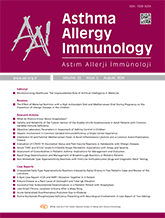


Objective: Accurate decisions regarding the asthma control level are critical in asthma management. However, an objective laboratory parameter has not yet been defined for detecting asthma control levels in children.
Materials and Methods: We aimed to determine objective laboratory parameters that can be used in evaluating the asthma control level. To achieve this, we compared the Global Initiative for Asthma (GINA)-defined asthma control scale with the Pediatric Asthma Control Test and laboratory parameters including serum periostin, tryptase, urinary leukotriene E4, and fractional exhaled nitric oxide levels in determining the control level of asthma in 160 children with asthma.
Results: The serum periostin level and FeNO level were significantly high and the median Pediatric Asthma Control Test score was significantly low in uncontrolled patients (p<0.001, p=0.003, p<0.001, respectively). After ROC analysis, p-ACT (AUC:0.914, %95CI:0.86-0.97, p<0.001), serum periostin (AUC:0,669, %95CI:0.59-0.75, p=0.001) and FeNO (AUC:0.755, %95CI:0.67-0.84, p<0.001) were found to be predictive in the assessment of asthma control. There was inconsistency between the GINA-defined asthma control scale and the Pediatric Asthma Control Test in 28.7% of the study group. Within the patients having controlled asthma according to both the GINA-defined asthma control scale and Pediatric Asthma Control Test, 8.7% had high levels of periostin and FeNO. Besides, serum periostin levels and FeNO levels were both normal in 25.0% of the patients with uncontrolled asthma according to the GINAdefined asthma control scale and the Pediatric Asthma Control Test.
Conclusion: The asthma control status demonstrated a correlation with FeNO and serum periostin levels. We hold the belief that incorporating objective laboratory parameters, such as FeNO and serum periostin, for the assessment of asthma control levels may have the potential to mitigate both overtreatment and undertreatment in the management of asthma.